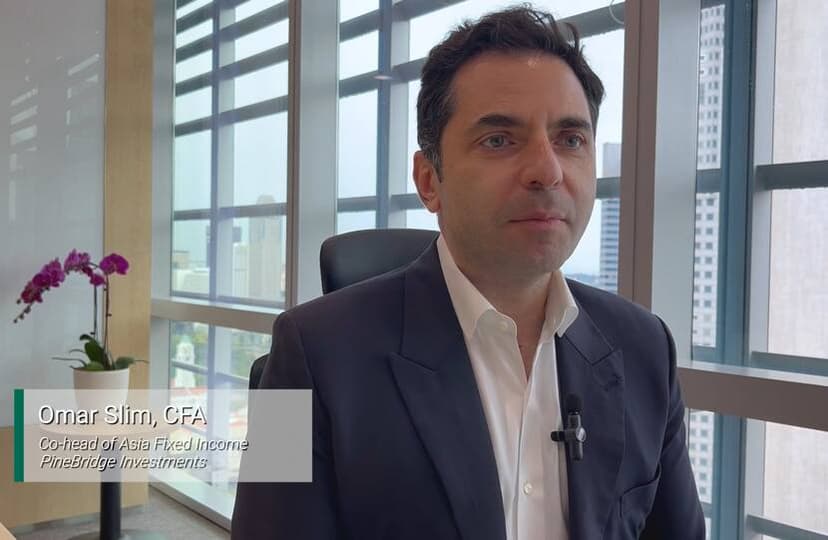Asia High Yield: Still Attractively Valued Amid Declining Default Rates

Andy Suen, CFA, FRM
Co-Head of Asia Fixed Income

Omar Slim, CFA
Co-Head of Asia Fixed Income

Kelvin Heng
Portfolio Manager and Credit Analyst, Fixed Income

Fan Zhang, CFA
Portfolio Manager & Credit Analyst, Fixed Income

Kevin Chow
Credit Analyst, Fixed Income
Asia high yield’s solid performance in the first half of 2024 is likely to continue due to falling default rates, enhanced market diversification, and high yield carry.
In China, recent measures supporting the housing market reduce the risk of a further deflationary spiral, but we believe more action is needed to stabilize the property sector.
The broader Asian economy remains robust, and we continue to see opportunities for investors to gain exposure to the world’s fastest-growing region.
In this dynamic environment, active managers with disciplined investment processes are well-positioned to generate alpha.

After several challenging years owing to China’s property crisis, Asia high yield (HY) bonds delivered their strongest showing in the first half of 2024 than in any comparable period since the global financial crisis. With a total return of 10.5%, Asia HY also outperformed other major credit markets, including US high yield (+2.6%) and global high yield (+3.2%), which have been more sensitive to rate volatility.1
While the distressed segment led the rally, high-quality Asia HY bonds have also performed well: the HY index excluding CCC rated securities delivered 8.5% in total return. This robust performance is unsurprising given the asset class’s elevated starting yield of 14.5% (or 11.8% excluding CCC rated bonds) and the stable or even improving credit fundamentals outside China’s property sector – as we have been highlighting over the past two years.
Asia’s High Yield Market Is Outpacing Global Peers
1H24 Returns

Source: JP Morgan, Bloomberg, PineBridge Investments. As of 28 June 2024.
As the Asia HY market approaches the end of its latest default cycle, we believe it continues to offer attractive valuations and opportunities for disciplined credit selectors, due to the following factors:
1) Declining overall default rates and a healthy Asia ex China property sector
The Chinese property sector crisis caused Asia HY corporate defaults to spike to 16.8% in 2022 and 10% in 2023. With the sector now much smaller, we expect default rates to continue to moderate to an estimated 4.5% this year. Moreover, the rest of the market has remained healthy. Excluding China property, default rates in the asset class stood at a mere 0.3% in the first half of this year. We expect 2024 and 2025 default rates to stay below the historical average of 2% for Asia HY ex China property.
While defaults in Asia have dominated headlines in recent years, Asia HY ex China property has historically maintained a lower default rate than US HY. We expect this trend to continue over the next two years, supported by the region's healthy macroeconomic backdrop, issuers’ robust access to cheaper local funding channels, and a fairly distributed maturity schedule.
Asia High Yield (ex. China Property) Defaults Have Been Lower Than for US HY

Source: JP Morgan, PineBridge Investments. As of 26 June 2024. Any opinions, projections, forecasts, or forward-looking statements presented are valid only as of the date indicated and are subject to change. Past performance, or any prediction or forecast, is not indicative of future performance.
2) Improved diversification in regional and sector composition
Compared to three years ago, the Asia HY market is now much more diversified. China’s weight in the JACI HY index has fallen significantly, from over 50% in the second quarter of 2021 to 25% in the second quarter of this year. Notably, China HY real estate – once the largest segment of Asia HY, with a 35% weight – is now less than 10% of the market and is expected to shrink further over time. The rebalancing of the index results in increased diversification for investors, allowing them to mitigate challenges in specific sectors or regions with opportunities in other market segments and reducing risk overall.
Asia HY Has Grown More Diverse as China’s Contribution Drops
Regional distribution by market cap

Sector distribution by market cap

Source: JP Morgan, PineBridge Investments. As of 28 June 2024.
3) High yield carry
Asia HY continues to offer higher yields relative both to historical averages and developed market HY bonds. Asia HY’s 12.3% yield was some 4.4 percentage points higher than the yield for US HY as of 28 June 2024. Even when excluding the lower-quality buckets, JACI HY ex CCC is yielding 10.5% and JACI HY ex China is yielding 9.9% – still higher than developed market HY. These levels are at the higher end of their 10-year historical range, close to the 90th percentile. In addition, while credit spreads for many markets have narrowed to some of their tightest levels since the global financial crisis, Asia HY is one of the few market segments that still offer potential for spread compression.
Yields Are Higher for Asia HY Relative to US and Global Levels
Yield to worst

Source: JP Morgan, Bloomberg, PineBridge Investments. As of 28 June 2024.
Our outlook for China focuses on select companies
Delving into China, while the government has unveiled its most significant steps yet to tackle the three-year slowdown, these policy measures have been highly targeted to manage growth and avoid systemic risks, as we expected.
We view the recent supportive measures for the housing market as positive steps toward reducing the risk of a further deflationary spiral, but believe more action is needed to stabilize the property market. We remain cautious on the outlook for the sector and believe investors should stay highly discerning, focusing on select names with quality rental portfolios.
That said, the dramatic reduction in the size of China’s property bond market means that the Asia HY universe is now more diversified than it was three years ago, and the sector’s impact on overall index returns is much less significant than before.
Outside of property, we see opportunities in select industrial companies in China. These are benefiting from pro-growth policies and the loose monetary policy stance, which is bolstering access to cheap funding. The onshore and offshore funding cost differential remains significant, creating dislocation opportunities in the offshore bonds of select high quality HY companies that have access to onshore channels.
Opportunities beyond mainland China
Away from the mainland, the macro environment of the broader Asian market remains robust, and we continue to see opportunities for investors to gain exposure to the world’s fastest-growing region.
We continue to favor Macau’s gaming sector, where fundamentals are still improving following the territory’s Covid reopening. Macau’s gross gaming revenue has recovered to 75% of its pre-Covid levels, and we expect gaming EBITDA to surpass pre-Covid levels in 2025. We believe bonds will enjoy support from the positive credit rating trajectory and issuers’ proactive management of maturity profiles.
We see opportunities in select Indian corporates that are well-positioned to benefit from the country’s robust economic expansion. One example is the renewable energy sector, which continues to benefit from structural tailwinds catalyzed by the country’s ambitious goal of generating half of its electricity from non-fossil fuels by 2030.
We also like select commodity-related issuers in Indonesia. These companies have strengthened their balance sheets and are also benefiting from cheaper local funding channels, which enhance their financial flexibility.
In sum, Asia HY bonds present a compelling investment case, offering falling default rates, high yields, and diverse opportunities across a range of countries and sectors. In this dynamic environment, active managers with robust investment processes are well-positioned to generate alpha.
1 Asia HY: JP Morgan JACI Non-Investment Grade Index; US HY: Bloomberg US Corporate High Yield Bond Index; Global HY: Bloomberg Global High Yield Bond Index. As of 28 June 2024.
Disclosure
Investing involves risk, including possible loss of principal. The information presented herein is for illustrative purposes only and should not be considered reflective of any particular security, strategy, or investment product. It represents a general assessment of the markets at a specific time and is not a guarantee of future performance results or market movement. This material does not constitute investment, financial, legal, tax, or other advice; investment research or a product of any research department; an offer to sell, or the solicitation of an offer to purchase any security or interest in a fund; or a recommendation for any investment product or strategy. PineBridge Investments is not soliciting or recommending any action based on information in this document. Any opinions, projections, or forward-looking statements expressed herein are solely those of the author, may differ from the views or opinions expressed by other areas of PineBridge Investments, and are only for general informational purposes as of the date indicated. Views may be based on third-party data that has not been independently verified. PineBridge Investments does not approve of or endorse any republication of this material. You are solely responsible for deciding whether any investment product or strategy is appropriate for you based upon your investment goals, financial situation and tolerance for risk.



